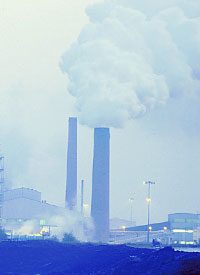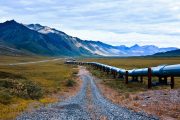
The cap: Each large-scale emitter, or company, will have a limit on the amount of greenhouse gas that it can emit. The firm must have an "emissions permit" for every ton of carbon dioxide it releases into the atmosphere. These permits set an enforceable limit, or cap, on the amount of greenhouse gas pollution that the company is allowed to emit….
The trade: It will be relatively cheaper or easier for some companies to reduce their emissions below their required limit than others. These more efficient companies, who emit less than their allowance, can sell their extra permits to companies that are not able to make reductions as easily….
Companies unable to meet their emissions quotas could purchase allowances from other companies that have acquired more permits than they need to account for their emissions. The cost of buying and selling these credits would be determined by the marketplace.
Another explanation appears in an article appearing on the Congressional Budget Office website: "Another approach would be to establish a ‘cap-and-trade’ program: The government would set gradually tightening limits on emissions, issue rights (or allowances) corresponding to those limits, and then allow firms to trade the allowances."
In today’s society, where "global warming" is a term that pops up in conversation and print almost daily, the cap-and-trade scheme may appear to many to be a cost-efficient way to help forestall an environmental crisis of legendary proportions. However, upon closer examination, both the economic and environmental arguments used to justify cap and trade are found to be based on specious evidence.
Bloomberg News reported on March 12 that the budget that President Obama proposed in February anticipated revenues of almost $650 billion by 2019 from a cap-and-trade program. The president’s proposal would require companies to buy government-issued permits to release carbon-dioxide into the atmosphere. One of the best explanations of the economic realities of cap and trade, written by Patrick Semmens, was posted on the Ron Paul blog on March 9. It is entitled: "’Cap and Trade’ Is Really Just a Massive Tax." As the writer explains: "Putting a price on carbon is regressive by definition because poor and middle-income households spend more of their paychecks on things like gas to drive to work, groceries or home heating."
As to why he considers cap-and-trade to be a regressive tax, Semmens cites none other than Peter Orszag, Obama’s budget director, who has estimated that the price hikes from a 15-percent cut in emissions would cost the average household in the bottom-income quintile (20 percent of the population) about 3.3 percent of its after-tax income every year. That’s about $680, not including the costs of reduced employment and output. The three middle quintiles would see their paychecks cut between $880 and $1,500, or 2.9 to 2.7 percent of income. The richest Americans would pay 1.7 percent.
As Semmens summarizes the plan: "Cap and trade, in other words, is a scheme to redistribute income and wealth — but in a very curious way. It takes from the working class and gives to the affluent; takes from Miami, Ohio, and gives to Miami, Florida; and takes from an industrial America that is already struggling and gives to rich Silicon Valley and Wall Street "green tech" investors who know how to leverage the political class."
U.S. Representative Marsha Blackburn (R-Tenn.) has said that Obama’s "cap and trade," which she calls "cap and tax," will cost each household $1,300 in new energy taxes.
Toni Johnson, a staff writer for CFR.org, the website of the powerful policy group, the Council on Foreign Relations, posted a series of interviews on March 19 seeking opinions about "Cap and Trade’s Economic Impact." As might be expected, since the CFR has a long-standing history of advocating policies that increase the size and scope of government — both domestically and internationally — the majority of those interviewed expressed opinions at least somewhat favorable to cap and trade. However, even in a forum dedicated to expounding the views of America’s ruling establishment, there were two dissenting views.
William Yeatman, Energy Policy Analyst for the Competitive Enterprise Institute, said: "A cap-and-trade system necessarily harms the economy because it is designed to raise the cost of energy. Given the current economic crisis, an expensive energy policy is a bad idea." Yeatman called the cap-and-trade plan "a roundabout energy tax," proposed in lieu of a direct tax because politicians "are terrified of the ‘t-word.’" He predicted that if the Obama cap-and-trade plan raised its projected $645 billion in revenue from the government-run emissions auctions, "everyone would feel the pinch. Businesses would compensate for higher production costs and diminished markets by slashing jobs. Consumers would have to pay more for energy and energy intensive goods."
Another expert interviewed by Johnson who warned of the economic consequences of a cap-and-trade plan was Dr. Sergey V. Mityakov, assistant professor in the Department of Economics at Clemson University and the coauthor of The Cost of Climate Regulation for American Households, published by the George C. Marshall Institute. Dr. Mityakov came straight to the point by saying: "Restricting carbon emissions by cap and trade is probably not a good idea even in a booming economy. Many studies assessing the costs of mitigation of climate change (either through some cap-and-trade system or by means of a carbon tax) indicate that the losses in consumer welfare are likely to be enormous."
Dr. Mityakov warned that the imposition of a cap-and-trade plan would severely impact Americans in multiple ways. He noted that consumers would "suffer directly from the increased prices of the energy and energy-intensive goods they buy." Furthermore, "higher energy prices will increase the production costs of American producers, making American-produced goods less competitive in the world market." He also warned that because of increased energy costs and competition from abroad, some American companies would shift their production overseas where no cap-and-trade system is operating, moves that "are likely to lead to additional job losses in the United States, further increasing the costs of the recession for the American households."
Another article citing the adverse effects of cap and trade is "Obama’s Self-Immolating Capitalism," by Will Wilkinson, a research fellow at the Cato Institute. Wilkinson wrote:
A cap and trade system would introduce a new market fabricated by government to regulate the entire economy of mundane markets. Cap and trade is based on the political invention of scarcity. But the problem of determining the ideal supply of emission permits is much like the Federal Reserve’s problem of determining the ideal quantity of government money. In both cases, bureaucrats must appeal to dubious mathematical models and pronounce on questions that remain the subject of raging scientific controversy…. The reality of cap and trade will be a typical political market: an expensive ramshackle compromise of competing forces.
Another article, "The Costs of Cap-and-Trade," by Raymond J. Keating, chief economist with the Small Business & Entrepreneurship Council, cited the November 8, 2007 testimony of Anne E. Smith, Ph.D. (a nationally known expert in environmental policy assessment and corporate compliance strategy planning) before the Senate’s Committee on Environment and Public Works. In her testimony, Dr. Smith presented the findings of a study done by CRA International assessing the economic costs of the "America’s Climate Security Act of 2007" (S. 2191) cosponsored by U.S. Senators Joseph Lieberman (I-Conn.) and John Warner (R-Va.). Among Dr. Smith’s findings:
- S. 2191 would decrease U.S. average economic welfare by 1.1 percent to 1.7 percent.
- The bill would cause real annual spending per household to be reduced by an average of $800 to $1,300 in 2015. These spending impacts would increase to levels of $1,500 to over $2,500 by the end of our modeled time period, 2050.
- GDP (Gross Domestic Product) would be lower in 2015 by about $160 billion to $250 billion. Eventually, the annual loss in GDP would increase to the range of $800 billion to $1 trillion (stated in real, 2007 dollars).
- There would be 1.2 million to 2.3 million net job losses by 2015. By 2020, the study projects between 1.5 million and 3.4 million net job losses.
We could cite other sources, but the above sampling makes an excellent case that the economic costs of cap and trade would be substantial. Even so, some would argue that any economic cost is worth enduring, if global warming can be forestalled. However, this argument ignores one critical factor: credible scientific evidence has not been presented to prove that any increase in the average temperature of the Earth is anthropogenic — caused by man’s activities.
Global-warming doomsayers tend to ignore the history of the Earth’s temperatures, which have constantly varied. Climate scientist Dr. Richard Lindzen has pointed out that "two centuries ago, much of the Northern Hemisphere was emerging from a little ice age. A millennium ago, during the Middle Ages, the same region was in a warm period. Thirty years ago, we were concerned with global cooling." During the global-cooling scare of the 1970s, some observers even worried that the planet was on the verge of a new ice age!
As for man’s impact on global temperatures, In the April 3 issue of the Wall Street Journal, deputy editor George Melloan noted that, according to "serious scientists," "the greenhouse gases are a fundamental part of the biosphere, necessary to all life, and … industrial activity generates less than 5 percent of them, if that."
And the theory that CO2 is the prime culprit in so-called global warming may also be flawed. In the compendium Earth Report 2000, Dr. Roy Spencer, senior scientist for climate studies at NASA’s Marshall Space Flight Center, noted: "It is estimated that water vapor accounts for about 95 percent of the earth’s natural greenhouse effect, whereas carbon dioxide contributes most of the remaining 5 percent. Global warming projections assume that water vapor will increase along with any warming resulting from the increases in carbon dioxide concentrations."
Dr. Spencer points out that such assumptions are unproven, however, noting that "there remain substantial uncertainties in our understanding of how the climate system will respond to increasing concentrations of carbon dioxide and other greenhouse gases." He observes that the natural greenhouse effect that heats the Earth is offset by natural cooling processes. "In other words," concluded Dr. Spencer, "the natural greenhouse effect cannot be considered in isolation as a process warming the earth, without at the same time accounting for cooling processes that actually keep the greenhouse effect from scorching us all."
Until such time as better science supporting global-warming theories emerges, bankrupting our economy through cap and trade schemes is an imprudent solution to a non-existent problem.



